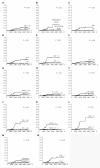Mild drinking habit is a risk factor for hepatocarcinogenesis in non-alcoholic fatty liver disease with advanced fibrosis
- PMID: 29632425
- PMCID: PMC5889824
- DOI: 10.3748/wjg.v24.i13.1440
Mild drinking habit is a risk factor for hepatocarcinogenesis in non-alcoholic fatty liver disease with advanced fibrosis
Abstract
Aim: The impact of mild drinking habit (less than 20 g/d of ethanol) on the clinical course of non-alcoholic fatty liver disease (NAFLD) has not been determined. We examined the influence of a mild drinking habit on liver carcinogenesis from NAFLD.
Methods: A total of 301 patients who had been diagnosed as having NAFLD by liver biopsy between 2003 and 2016 [median age: 56 years, 45% male, 56% with non-alcoholic steatohepatitis, 26% with advanced fibrosis (F3-4)] were divided into the mild drinking group with ethanol consumption of less than 20 g/d (mild drinking group, n = 93) and the non-drinking group (n = 208). Clinicopathological features at the time of liver biopsy and factors related to hepatocellular carcinoma (HCC) occurrence were compared between the groups.
Results: We observed significant differences in male prevalence (P = 0.01), platelet count (P = 0.04), and gamma-glutamyl transpeptidase (P = 0.02) between the test groups. Over 6 years of observation, the HCC appearance rate was significantly higher in the mild drinking group (6.5% vs 1.4%, P = 0.02). Multivariate survival analysis using Cox's regression model revealed that hepatic advanced fibrosis (F3-4) (P < 0.01, risk ratio: 11.60), diabetes mellitus (P < 0.01, risk ratio: 89.50), and serum triglyceride (P = 0.04, risk ratio: 0.98) were factors significantly related to HCC in all NAFLD patients, while the effect of a drinking habit was marginal (P = 0.07, risk ratio: 4.43). In patients with advanced fibrosis (F3-4), however, a drinking habit (P = 0.04, risk ratio: 4.83), alpha-fetoprotein (P = 0.01, risk ratio: 1.23), and diabetes mellitus (P = 0.03, risk ratio: 12.00) were identified as significant contributors to HCC occurrence.
Conclusion: A mild drinking habit appears to be a risk factor for hepatocarcinogenesis in NAFLD patients, especially those with advanced fibrosis.
Keywords: Ethanol; Hepatocellular carcinoma; Non-alcoholic fatty liver disease; Risk factor.
Conflict of interest statement
Conflict-of-interest statement: The authors declare that no conflict of interest exists.
Figures



Similar articles
-
Fibrosis Severity as a Determinant of Cause-Specific Mortality in Patients With Advanced Nonalcoholic Fatty Liver Disease: A Multi-National Cohort Study.Gastroenterology. 2018 Aug;155(2):443-457.e17. doi: 10.1053/j.gastro.2018.04.034. Epub 2018 May 5. Gastroenterology. 2018. PMID: 29733831
-
Clinical features of hepatocellular carcinoma in nonalcoholic fatty liver disease patients without advanced fibrosis.J Gastroenterol Hepatol. 2019 Sep;34(9):1626-1632. doi: 10.1111/jgh.14608. Epub 2019 Mar 6. J Gastroenterol Hepatol. 2019. PMID: 30668889
-
Hepatocarcinogenesis in non-alcoholic fatty liver disease in Japan.J Gastroenterol Hepatol. 2013 Dec;28 Suppl 4:88-92. doi: 10.1111/jgh.12239. J Gastroenterol Hepatol. 2013. PMID: 24251711 Review.
-
Long-term outcomes of non-alcoholic fatty liver disease and the risk factors for mortality and hepatocellular carcinoma in a Japanese population.J Gastroenterol Hepatol. 2020 Sep;35(9):1579-1589. doi: 10.1111/jgh.14989. Epub 2020 Feb 5. J Gastroenterol Hepatol. 2020. PMID: 31975453
-
Nonalcoholic fatty liver disease, metabolic risk factors, and hepatocellular carcinoma: an open question.World J Gastroenterol. 2015 Apr 14;21(14):4103-10. doi: 10.3748/wjg.v21.i14.4103. World J Gastroenterol. 2015. PMID: 25892859 Free PMC article. Review.
Cited by
-
Comparison of Clinical Manifestations and Related Factors of Hepatocellular Carcinoma with Chronic Hepatitis B.Int J Gen Med. 2024 Jun 25;17:2877-2886. doi: 10.2147/IJGM.S464083. eCollection 2024. Int J Gen Med. 2024. PMID: 38947567 Free PMC article.
-
Alcohol consumption in non-alcoholic fatty liver disease-harmful or beneficial?Hepatobiliary Surg Nutr. 2019 Jun;8(3):311-313. doi: 10.21037/hbsn.2019.01.13. Hepatobiliary Surg Nutr. 2019. PMID: 31245423 Free PMC article. No abstract available.
-
Global epidemiology of type 2 diabetes in patients with NAFLD or MAFLD: a systematic review and meta-analysis.BMC Med. 2024 Mar 6;22(1):101. doi: 10.1186/s12916-024-03315-0. BMC Med. 2024. PMID: 38448943 Free PMC article.
-
The importance of patient engagement in the multimodal treatment of MASLD.Commun Med (Lond). 2025 May 1;5(1):148. doi: 10.1038/s43856-025-00871-1. Commun Med (Lond). 2025. PMID: 40312453 Free PMC article. Review.
-
Alcohol Use Is Associated With Hepatic Steatosis Among Persons With Presumed Nonalcoholic Fatty Liver Disease.Clin Gastroenterol Hepatol. 2020 Jul;18(8):1831-1841.e5. doi: 10.1016/j.cgh.2019.11.022. Epub 2019 Nov 14. Clin Gastroenterol Hepatol. 2020. PMID: 31734449 Free PMC article.
References
-
- Vernon G, Baranova A, Younossi ZM. Systematic review: the epidemiology and natural history of non-alcoholic fatty liver disease and non-alcoholic steatohepatitis in adults. Aliment Pharmacol Ther. 2011;34:274–285. - PubMed
-
- Younossi ZM, Koenig AB, Abdelatif D, Fazel Y, Henry L, Wymer M. Global epidemiology of nonalcoholic fatty liver disease-Meta-analytic assessment of prevalence, incidence, and outcomes. Hepatology. 2016;64:73–84. - PubMed
-
- Eguchi Y, Hyogo H, Ono M, Mizuta T, Ono N, Fujimoto K, Chayama K, Saibara T; JSG-NAFLD. Prevalence and associated metabolic factors of nonalcoholic fatty liver disease in the general population from 2009 to 2010 in Japan: a multicenter large retrospective study. J Gastroenterol. 2012;47:586–595. - PubMed
-
- Sanyal AJ, Campbell-Sargent C, Mirshahi F, Rizzo WB, Contos MJ, Sterling RK, Luketic VA, Shiffman ML, Clore JN. Nonalcoholic steatohepatitis: association of insulin resistance and mitochondrial abnormalities. Gastroenterology. 2001;120:1183–1192. - PubMed
Publication types
MeSH terms
Substances
LinkOut - more resources
Full Text Sources
Other Literature Sources
Medical
Miscellaneous

